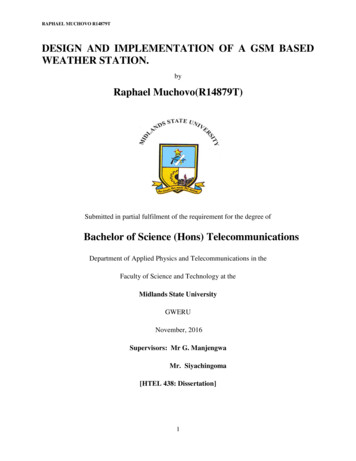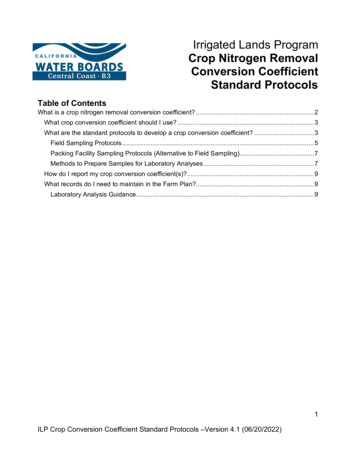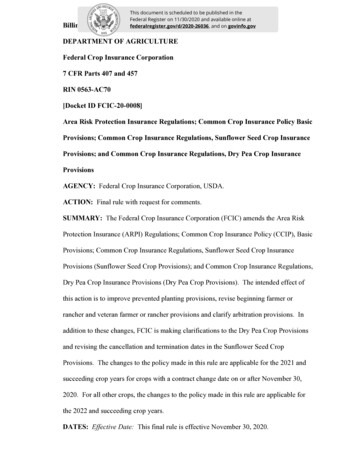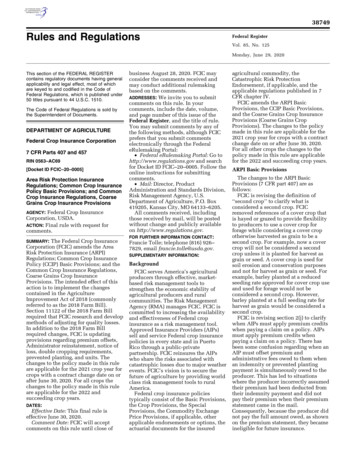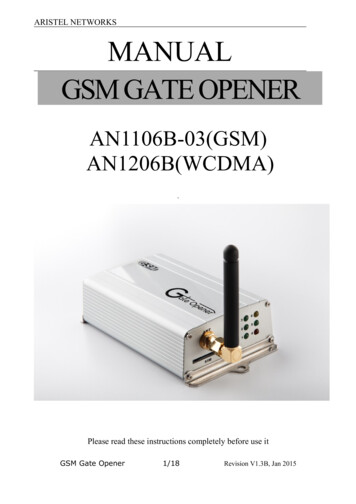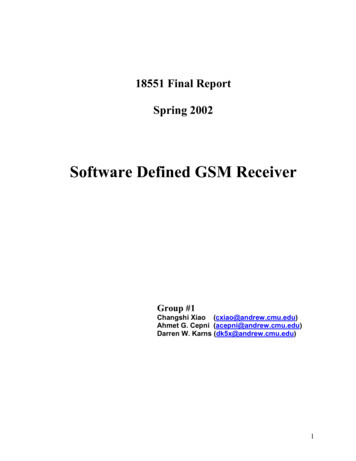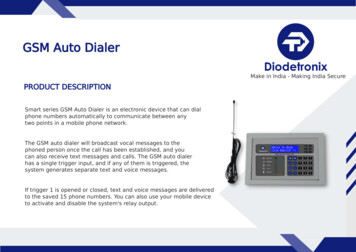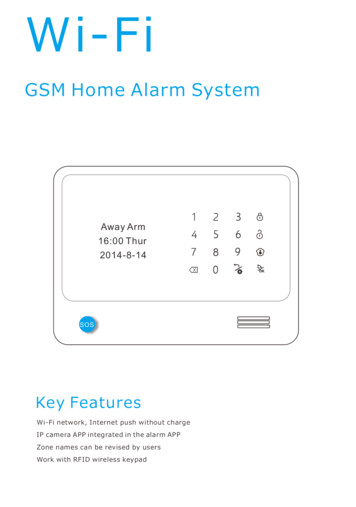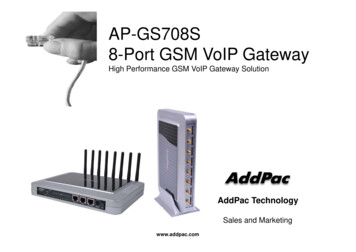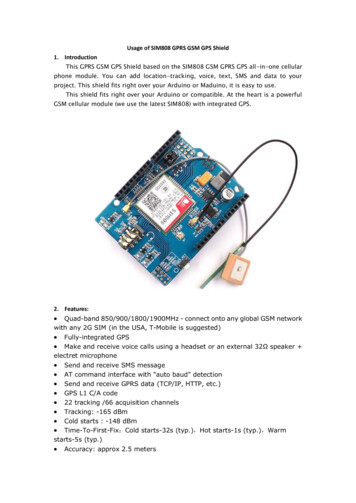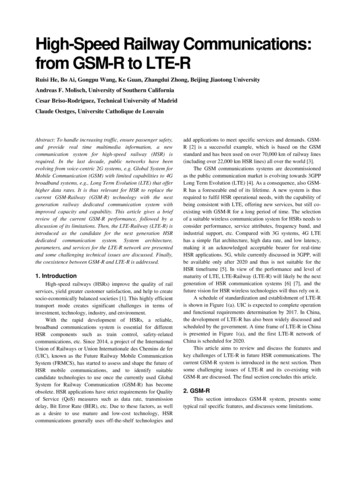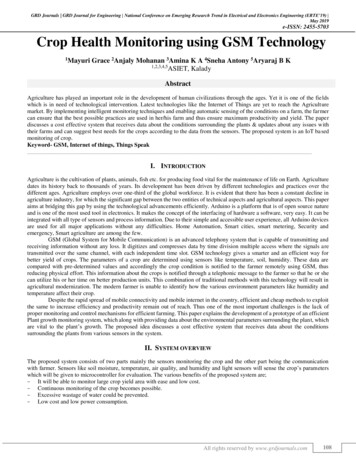
Transcription
GRD Journals GRD Journal for Engineering National Conference on Emerging Research Trend in Electrical and Electronics Engineering (ERTE’19) May 2019e-ISSN: 2455-5703Crop Health Monitoring using GSM Technology1MayuriGrace 2Anjaly Mohanan 3Amina K A 4Sneha Antony 5Aryaraj B K1,2,3,4,5ASIET, KaladyAbstractAgriculture has played an important role in the development of human civilizations through the ages. Yet it is one of the fieldswhich is in need of technological intervention. Latest technologies like the Internet of Things are yet to reach the Agriculturemarket. By implementing intelligent monitoring techniques and enabling automatic sensing of the conditions on a farm, the farmercan ensure that the best possible practices are used in her/his farm and thus ensure maximum productivity and yield. The paperdiscusses a cost effective system that receives data about the conditions surrounding the plants & updates about any issues withtheir farms and can suggest best needs for the crops according to the data from the sensors. The proposed system is an IoT basedmonitoring of crop.Keyword- GSM, Internet of things, Things SpeakI. INTRODUCTIONAgriculture is the cultivation of plants, animals, fish etc. for producing food vital for the maintenance of life on Earth. Agriculturedates its history back to thousands of years. Its development has been driven by different technologies and practices over thedifferent ages. Agriculture employs over one-third of the global workforce. It is evident that there has been a constant decline inagriculture industry, for which the significant gap between the two entities of technical aspects and agricultural aspects. This paperaims at bridging this gap by using the technological advancements efficiently. Arduino is a platform that is of open source natureand is one of the most used tool in electronics. It makes the concept of the interfacing of hardware a software, very easy. It can beintegrated with all type of sensors and process information. Due to their simple and accessible user experience, all Arduino devicesare used for all major applications without any difficulties. Home Automation, Smart cities, smart metering, Security andemergency, Smart agriculture are among the few.GSM (Global System for Mobile Communication) is an advanced telephony system that is capable of transmitting andreceiving information without any loss. It digitizes and compresses data by time division multiple access where the signals aretransmitted over the same channel, with each independent time slot. GSM technology gives a smarter and an efficient way forbetter yield of crops. The parameters of a crop are determined using sensors like temperature, soil, humidity. These data arecompared with pre-determined values and accordingly the crop condition is notified to the farmer remotely using GSM, thusreducing physical effort. This information about the crops is notified through a telephonic message to the farmer so that he or shecan utilize his or her time on better production units. This combination of traditional methods with this technology will result inagricultural modernization. The modern farmer is unable to identify how the various environment parameters like humidity andtemperature affect their crop.Despite the rapid spread of mobile connectivity and mobile internet in the country, efficient and cheap methods to exploitthe same to increase efficiency and productivity remain out of reach. Thus one of the most important challenges is the lack ofproper monitoring and control mechanisms for efficient farming. This paper explains the development of a prototype of an efficientPlant growth monitoring system, which along with providing data about the environmental parameters surrounding the plant, whichare vital to the plant’s growth. The proposed idea discusses a cost effective system that receives data about the conditionssurrounding the plants from various sensors in the system.II. SYSTEM OVERVIEWThe proposed system consists of two parts mainly the sensors monitoring the crop and the other part being the communicationwith farmer. Sensors like soil moisture, temperature, air quality, and humidity and light sensors will sense the crop’s parameterswhich will be given to microcontroller for evaluation. The various benefits of the proposed system are;– It will be able to monitor large crop yield area with ease and low cost.– Continuous monitoring of the crop becomes possible.– Excessive wastage of water could be prevented.– Low cost and low power consumption.All rights reserved by www.grdjournals.com108
Crop Health Monitoring using GSM Technology(GRDJE / CONFERENCE / ERTE’19/ 025)Fig. 1: Overall System StructureThe system works on the basis of communication between the mobile phone of the farmer and a Microcontroller of the system.The block diagram of the system is as shown in the Fig 2. The circuit design mainly consists of four parts;A. Sensing PartThe sensors are placed around the crop to be monitored. The various sensors such as soil moisture, air quality, light, humidity andtemperature sense their respective values and are given to the Arduino microcontroller. The microcontroller makes a sense of thesevalues obtained.B. Display PartThe various values obtained is then send to LCD for the display of the crop’s parameters. The data transmission occurring betweenthe LCD and Arduino will be a 4-bit data transmission. The LCD will display different sensor data on it for every 5 second. Thenat last LCD will display the health status of crop.C. Uploading PartThe sensor values obtained is then uploaded to the Thing Speak server using ESP8266 Wi-Fi module. The interface occurringbetween the Arduino and the Wi-Fi module will be based on the use of AT commands. The Wi-Fi module obtains the internet fromthe hotspot connection available. Once it obtains the internet, value gets uploaded.D. Alerting PartThe alerting part is the most important part where the farmer gets alerted of any problems happening with the crop’s parameters.The Arduino has been programmed such that when farmer gives a missed call on the GSM SIM900A module a message is send tothe farmer with details of crop’s parameters. The farmer could also view his crop’s parameters on the Thing Speak website whereit is depicted in a graphical manner and necessary steps could be taken.E. Irrigation PartThere is a motor which is used for the irrigation purpose when the moisture of the soil goes below a certain value.Fig. 2: Block Diagram of the SystemAll rights reserved by www.grdjournals.com109
Crop Health Monitoring using GSM Technology(GRDJE / CONFERENCE / ERTE’19/ 025)Arduino is the main block of this proposed system as it is the MCU of the system. It is portable, easy to use. GSM is an importantblock as it will transfer the gathered data to the receiving end (wireless). Environmental conditions will affect the overall yield ofthe crop. Plants require specific conditions for optimal growth and health, monitoring the condition of the crop is necessary sosensors are used. Temperature and humidity sensor – DHT-11 is used for sensing the temperature and humidity of the surroundingcrop so that it can be monitored properly.F. Connection DiagramFig. 3: Connection Diagram of the systemIII. HARDWARE COMPONENTSA. Arduino UnoArduino Uno is a microcontroller board based on the ATmega328. It has 14 digital input / output pins (of which 6 can be used asPWM outputs), 6 analog inputs, 16 MHz ceramic resonator, USB connection, power jack, ICSP plug, and a reset button. It containseverything needed to support the microcontroller; simply use the USB cable or power it with a AC-to-DC adapter or battery isconnected to a computer begins.Fig. 4: Arduino Uno ATmega328B. DHT-11 (Relative Humidity and Atmospheric Temperature) SensorThe DHT-11 is used for measuring humidity and atmospheric temperature. This sensor is typically used in air conditioners forrelative humidity measurement, control and display. It has an operating temperature range of 0ºC to 50ºC, and an operatinghumidity range from 20% RH to 80% RH, which is the typical humidity range of coastal Kerala.All rights reserved by www.grdjournals.com110
Crop Health Monitoring using GSM Technology(GRDJE / CONFERENCE / ERTE’19/ 025)Fig. 5: DHT-11 SensorC. Soil Moisture SensorSoil moisture sensor is used to measure the volumetric water content of soil. It measures the loss of moisture over time due toevaporation and plant uptake and evaluate optimum soil moisture contents for various species of plants.Fig. 6: Soil Moisture SensorThe sensor consists of two probes. The probe has been designed and waterproofed such that it can be completely immersedinto water for durations of time and left buried in soil. This device will be an important use to the farmers as by noting the moisturecontent of the soil, they can determine the proper growth of crop. These values are fed to GSM via Arduino to be sent to the farmer.D. Air Quality Sensor MQ-6The MQ-6 can detect gas concentrations anywhere from 200 to 10000ppm. This sensor has a high sensitivity and fast responsetime. The sensor's output is an analogy resistance. The drive circuit is very simple, all you need to do is power the heater coil with5V, add a load resistance, and connect the output to an ADC.Fig. 7: MQ-6 Air quality sensorE. LDR -Light Depending Resistor SensorA Light Dependent Resistor (LDR) or a photo resistor is a device whose resistivity is a function of the incident electromagneticradiation. LDR is used for detecting the amount of light. LDR’s are light dependent devices whose resistance is decreases andincreases depending upon light intensity.Fig. 8: LDR SensorWhen a light dependent resistor is kept in dark, its resistance is very high. If the device is allowed to absorb light itsresistance will be decreased drastically. This is used in the circuit for the purpose of detecting the amount of sunlight hitting thecrop. The other reason for its use is when the sunlight gets blocked by some external means the farmer gets quickly alerted.All rights reserved by www.grdjournals.com111
Crop Health Monitoring using GSM Technology(GRDJE / CONFERENCE / ERTE’19/ 025)F. GSM SIM900A ModuleThis is an ultra-compact and reliable wireless module. The SIM900A is a complete dual band GSM solution in a SMT modulewhich can be embedded in the customer applications. Featuring an industry-standard interface, the SIM900A delivers GSM900/1800MHz performance for voice, SMS, Data in a small form factor and with low power consumption.Fig. 9: GSM SIM900A ModuleWith a tiny configuration of 24mmx24mmx3mm, SIM900A can fit in almost all the space requirements in userapplications, especially for slim and compact demand of design. For its working insert a valid SIM card and connect the Arduinowith Arduino IDE.G. ESP8266 Wi-Fi ModuleESP8266 is Wi-Fi enabled system on chip Module. It is mostly used for development of IoT (Internet of Things) embeddedapplications. ESP8266 Wi-Fi module which is having TCP/IP protocol stack integrated on chip. So that it can provide anymicrocontroller to get connected with Wi-Fi network.Fig. 10: ESP8266 Wi-Fi ModuleESP8266 is a pre-programmed SOC and any microcontroller has to communicate with it through UART interface. Itworks with a supply voltage of 3.3V. The module is configured with AT commands and the microcontroller should be programmedto send the AT commands in a required sequence to configure the module.H. DC Water PumpFig. 11: DC Water pumpA submersed direct current water pump is used for purpose of irrigation. The water pump is used to channel water to the plantsfrom the water tank. It is driven by the motor driver to the Arduino. The water pump will start working if the user has been informedthat the soil is dry on his/her mobile phone via GSM module and the user send instruction to water the plant, vice versa. It workswith 12V dc supply. The Arduino is controlling the motor pump via programming with the help of a driver IC called L293D.All rights reserved by www.grdjournals.com112
Crop Health Monitoring using GSM Technology(GRDJE / CONFERENCE / ERTE’19/ 025)IV. SOFTWARE AND WEB SERVICES USEDA. Serial MonitorSerial is used for communication between the Arduino board and a computer or other devices. All Arduino boards have at leastone serial port (also known as a UART or USART): Serial. It communicates on digital pins 0 (RX) and 1 (TX) as well as with thecomputer via USB. Thus, on using these functions, pins 0 and 1 cannot be used for digital input or output.Fig. 12: Serial Monitor Icon positionThe Arduino Integrated Development Environment (IDE) is the software side of the Arduino platform. And, becauseusing a terminal is such a big part of working with Arduinos and other microcontrollers, they decided to include a serial terminalwith the software. Within the Arduino environment, this is called the Serial Monitor. The Arduino IDE has a feature that can be agreat help in debugging sketches or controlling Arduino from the computer's keyboard. The Serial Monitor is a separate pop-upwindow that acts as a separate terminal that communicates by receiving and sending Serial Data. Serial Data consists of a series of1's and 0's sent over the wire. Data can be sent in both directions.Fig. 13: Serial MonitorThe Serial Monitor is a great quick and easy way to establish a serial connection with the Arduino. On working in theArduino IDE, there is really no need to open up a separate terminal to display data. All the connections such as interface betweenAll rights reserved by www.grdjournals.com113
Crop Health Monitoring using GSM Technology(GRDJE / CONFERENCE / ERTE’19/ 025)Arduino and SIM900A are checked using this Serial monitor. Same is the case with Wi-Fi module and Arduino. The message sendto the farmer is done with the help of Serial monitor.B. ThingsSpeak (Web Service)ThingsSpeak is an open source Internet of Things (IoT) application and API to store and retrieve data from things using the HTTPprotocol over the Internet or via a Local Area Network. It enables the creation of sensor logging applications, location trackingapplications, and a social network of things with status updates and offers free data storage and analysis of time-stamped numericor alphanumeric data. ThingsSpeak stores data in channels. It is an Internet of Things (IoT) platform that lets us collect and storesensor data in the cloud and develop IoT applications. The Thing Speak IoT platform provides apps that let you analyse andvisualize your data in MATLAB, and then act on the data. Sensed data can be sent to Thing Speak from Arduino, Raspberry Piand other hardware.Things Speak has integrated support from the numerical computing software MATLAB from Math Works AllowingThingsSpeak users to analyse and visualize uploaded data using Mat lab without requiring the purchase of a MATLAB licensefrom Math Works. The farmer could easily access the site by just entering his username and password. The values will be depictedin a graphical manner and viewer could easily make out the situation in the farm. The ThingsSpeak is also available as app onmobile with name ThingsSpeak Viewer app which also depicts the same graph.V. CONCLUSIONA solution for monitoring agricultural environments is presented. The system can act as an early warning system for upcomingthreats, a monitoring system constantly reporting on the status of farms for prospective farmers. It is claimed that such a system isrelevant in the network society and that there is sufficient technical knowledge to render its implementation which is not onlyfeasible, but also cost effective. The paper based on the IoT is certainly having vast applications and the drawbacks due to lesstechnological advancements were overcome and eliminated the strenuous and laborious efforts put in by farmers by saving theirtime and improving the quality of labour and its efficiency. This has been done by tracking the growth of the variety of crops onthe fields in a remote area and maintaining a database which compares data ensuring the health of these crops and hence makingthe system more time efficient. The system ensures this through wireless communication, that steps are undertaken by the farmersto prevent that. The application of such system can certainly prove to be a leap towards the technological advancements and highlybeneficial for society.Fig. 14: Proposed PrototypeVI. FUTURE SCOPEKeeping all the future aspects in mind, a 360degree thermal camera can be interfaced with the Arduino and connected with thedatabase of a cloud storage for thermal image processing. This would be a huge advantageous leap in the system as it would helpto track all kinds of agricultural activities including the advancements in the growth of crops at all times that can be controlledaccording to the received data from the cloud storage. The system monitors one plant at a time, and sends the sensed data of thatplant alone to the farmer. With slight modifications, several such sensor systems can be placed in a single farm, eachcommunicating with one another. With the use of machine learning algorithms, the system can give the user more detailedinformation about how the individual plants and the farm as a whole, is reacting to the current situation.REFERENCES[1] “Plant growth monitoring system, with dynamic user interface”, Jerrin James College of Engineering Trivandrum Universityof Kerala Trivandrum, India, IEEE Conference, 2015.[2] “GSM Activated Watering System Prototype”, N. S. Isaak, Aziati H. Awang, N. N. S. Bahri, A. M. M. Zaimi Faculty ofElectrical Engineering University Teknologi MARA Shah Alam, IEEE International RF and Microwave Conference,2015.All rights reserved by www.grdjournals.com114
Crop Health Monitoring using GSM Technology(GRDJE / CONFERENCE / ERTE’19/ 025)[3] “Automated Plant Watering System”, Drashti Divani Computer Engineering, SIES Graduate School of Technology,International Conference on Computation of Power, Energy Information and Communication,2016.[4] “Advanced Agriculture System using GSM Technology”, Arpit Mittal, IEEE International Conference on Communicationand Signal Processing, April, 2018.All rights reserved by www.grdjournals.com115
Fig. 4: Arduino Uno ATmega328 B. DHT-11 (Relative Humidity and Atmospheric Temperature) Sensor The DHT-11 is used for measuring humidity and atmospheric temperature. This sensor is typically used in air conditioners for relative humidity measurement, control and display. It has an operating temperature range of 0ºC to 50ºC, and an operating
